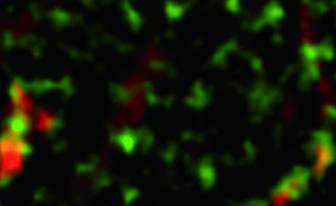Cover illustration

“Hypertonia-linked protein Trak1 functions with mitofusins to promote mitochondrial tethering and fusion”
Hypertonia is a neurological dysfunction in several central nervous system disorders, including cerebral palsy, Parkinson’s disease, and epilepsy. In this issue, Lee et al report that hypertonia-linked protein Trak1 is a new regulator of mitochondrial tethering and fusion with a critical role in maintaining mitochondrial and cell health under stress conditio
[Detail] ...
Development of ovarian cancer involves the co-evolution of neoplastic cells together with the adjacent microenvironment. Steps of malignant progression including primary tumor outgrowth, therapeutic resistance, and distant metastasis are not determined solely by genetic alterations in ovarian cancer cells, but considerably shaped by the fitness advantage conferred by benign components in the ovarian stroma. As the dynamic cancer topography varies drastically during disease progression, heterologous cell types within the tumor microenvironment (TME) can actively determine the pathological track of ovarian cancer. Resembling many other solid tumor types, ovarian malignancy is nurtured by a TME whose dark side may have been overlooked, rather than overestimated. Further, harnessing breakthrough and targeting cures in human ovarian cancer requires insightful understanding of the merits and drawbacks of current treatment modalities, which mainly target transformed cells. Thus, designing novel and precise strategies that both eliminate cancer cells and manipulate the TME is increasingly recognized as a rational avenue to improve therapeutic outcome and prevent disease deterioration of ovarian cancer patients.
Hypertonia is a neurological dysfunction associated with a number of central nervous system disorders, including cerebral palsy, Parkinson’s disease, dystonia, and epilepsy. Genetic studies have identified a homozygous truncation mutation in Trak1 that causes hypertonia in mice. Moreover, elevated Trak1 protein expression is associated with several types of cancersand variants in Trak1 are linked to childhood absence epilepsy in humans. Despite the importance of Trak1 in health and disease, the mechanisms of Trak1 action remain unclear and the pathogenic effects of Trak1 mutation are unknown. Here we report that Trak1 has a crucial function in regulation of mitochondrial fusion. Depletion of Trak1 inhibits mitochondrial fusion, resulting in mitochondrial fragmentation, whereas overexpression of Trak1 elongates and enlarges mitochondria. Our analyses revealed that Trak1 interacts and colocalizes with mitofusins on the outer mitochondrial membrane and functions with mitofusins to promote mitochondrial tethering and fusion. Furthermore, Trak1 is required for stress-induced mitochondrial hyperfusion and pro-survival response. We found that hypertonia-associated mutation impairs Trak1 mitochondrial localization and its ability to facilitate mitochondrial tethering and fusion. Our findings uncover a novel function of Trak1 as a regulator of mitochondrial fusion and provide evidence linking dysregulated mitochondrial dynamics to hypertonia pathogenesis.